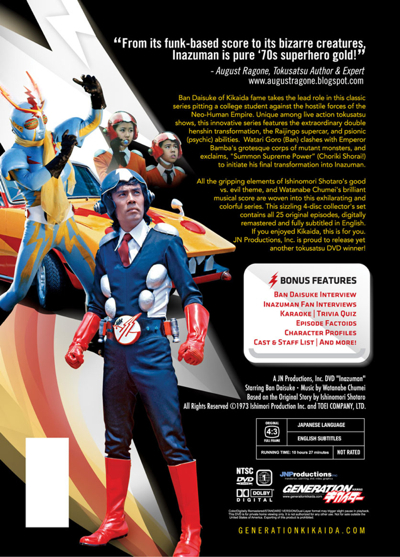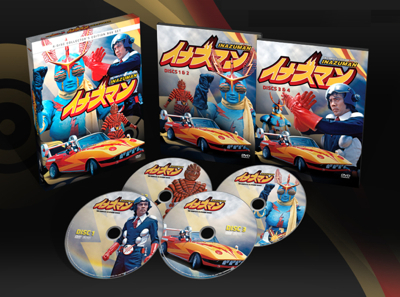『人造人間キカイダー』放送開始40周年!
 Original poster for the KIKAIDA 3D MOVIE! (1972) ©Toei Co., Ltd.
Original poster for the KIKAIDA 3D MOVIE! (1972) ©Toei Co., Ltd.
Riding astride his sidecar superbike, Jiro (Daisuke Ban), a young man clad in blue denim, with a guitar slung across his back, swings his arms and transforms into a red and blue combat android known as Kikaida. The yin-yang patterned android, with exposed circuitry flashing under his glass-domed head, smashes through hordes of monstrous automatons in order to save Mitsuko (Jun Mizunoe) and Masaru (Masahiro Kamiya), the children of the scientist who created him, Dr. Komyoji (Hajime Izu).
Kikaida's mission: to reunite Mitsuko and Masaru with their fugitive father, and bring down the sinister secret group known as the "Dark." This underground organization composed of monster androids, is masterminded by the evil Professor Gill (Mitsuo Ando), who plots to take over the world through subversion and violence. Only Kikaida stands in his way. But, like all legendary heroes, Kikaida has a flaw: an incomplete "Conscience Circuit," which keeps him from being the "perfect android" — a flaw that Professor Gill can exploit...
Conceived by the minds of Toei Creative Producer Tohru Hirayama and cartoonist Shotaro Ishimori, JINZONINGEN KIKAIDA (roughly translating as "Android Kikaider") debuted on the Nippon Educational Television network on July 8, 1972. This colorful, exciting and outlandish superhero series was produced by Toei Television Productions on the heels of the ratings successes of KAMEN RIDER (1971), SUPERHUMAN BAROM-1 (1972) and HENSHIN NINJA ARASHI (1972), during the "Henshin Boom" on Japanese television in the early 1970s — which spawned over 60 primetime superhero shows in less than a decade. Out of this wild cacophony, KIKAIDA still stands near the top of the heap today.
To Ishimori, this series gave him the opportunity to explore areas of the cybernetic/artifical superhero, which were rejected for the original KAMEN RIDER series. It also gave the great artist a chance to infuse the story with elements of his favorite story: "Pinocchio." The end result is a series that is a satisfying and more humanistic bookend to KAMEN RIDER. In the background of the series, Dr. Komyoji was kidnapped by Professor Gill, and forced to build legions of Dark Destructoids, before he disappears in a lab explosion, after completing his work on Jiro. His creation, made in the moral image of his deceased son, escapes with Mitsuko and rescues Masaru, and KIKAIDA's story begins in earnest. But, like many other series at this time, most of the episodes are, more or less, formulaic.
The majority of episodes generally follow the same pattern, with the amnestic Dr. Komyoji wandering in search of himself from town to town, with his children in close pursuit — aided by their comedy-relief sidekick, Ace Detective Hanpei (a descendent of the famous Iga ninja, Hanzo Hattori). Meanwhile, Professor Gill hatches another diabolical plot, schemes to recapture Dr. Komyoji, or tries to destroy Kikaida, by unleashing a new Dark Android in order to do his dirty work. Just when it seems that all is lost, the sound of a melancholy guitar announces the entrance of Jiro, who comes to thwart the Dark Destructoids' devious plans. Professor Gill counters by playing his cataleptic flute, which paralyzes Jiro, as his incomplete Conscience Circuit tries to resist the command to cross over to the Dark side. Jiro must resist the evil impulses to make the transformation to Kikaida and emerge victorious.
Interestingly, KIKAIDA changed radically with the introduction of Jiro's "brother," Saburo in Episode 36. Created by Professor Gill's greatest scientists, this knife-weilding, black leather-clad cyborg transformed into Kikaida's greatest foe: Hakaida. Stronger and more powerful than his older brother, Hakaida's "Evil Circuit" was programmed with but one mission: "Destroy Kikaida!" But, no one ever realizes the truth behind Hakaida's supremacy over his fellow Dark Destructoids: his cybernetic body is operated by a living, human brain — Dr. Komyoji's brain! It is in this last story arc of the series where the stories became more grim and less formulaic, as KIKAIDA reached its powerful and emotional crescendo.
While KIKAIDA wasn't allowed the budget to realize the ambitions of Ishimori's Dark Destructoid designs, as was achieved with KAMEN RIDER, KIKAIDA still had as much action, spirit and kinetic energy as its sister series. KIKAIDA also had something more important: a plot full of heart and soul, well-defined characters (whom you cared about), engaging subplots, and an amazing score by Michiaki "Chumei" Watanabe. To those who saw the series growing up, KIKAIDA left a great impression on its viewers and was successful enough to spawn a sequel: KIKAIDA-01 (1973-1974), both of which are still beloved today.
In the mid-'70s, KIKAIDA was aired on Japanese-language stations in Hawaii and California, and created a legion of fans who still love the show. I am Legion. Four decades later, we are still switching on to KIKAIDA!
The entire 43 episodes of KIKAIDA (plus the 3D Movie) are available on DVD, with English Subtitles, from Generation Kikaida!


























































